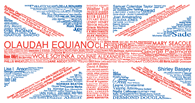Introduction
The Black community in Britain has been concerned with its history for the past 80 years at least. When the African Progress Union was formed in London in 1918, under the Presidency of John Richard Archer, former mayor of Battersea, one of its declared aims was to spread ‘knowledge of the history and achievements of Africans and Afro-Caribbeans past and present’. Twenty years later C.L.R James’s classic study of the Haitian revolution and the life of Toussaint-Louverture, The Black Jacobins (1938), published while its Trinidadian author was living in Britain, set the standard against which all later attempts to teach Black history must be judged.
Union Blacks - a portrait of Black Brits, has made a distinctive contribution to a proud tradition. The exibition focuses on personalities who have lived in Britain, and have contributed in different ways to the British experience. It makes this exhibition immediately accessible to the younger generation. Where is the Black child who, seeing assembled here these powerful images of men and women who have struggled and achieved against all the odds, will not be inspired to think: ‘These people made a success of their lives. And I can do the same!’
But this exhibition is important not only for Black people, young and old alike, White people too need to know something about Black History, without which the history of Britain and its former empire is seriously incomplete. British Black history fills a glaring gap in our vaunted ‘island story’. Black history and White history are in fact two sides of the same coin. They interpenetrate. They illuminate each other. To all who want to build a shared future free from the poison of racism, and who therefore seek the truth about our shared past, I commend this enlightening, stimulating, and inspiring exhibition.
Peter Fryer, 1998
